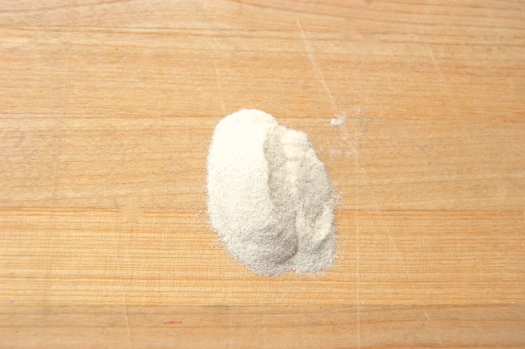Agar (Agar)

Agar is like carrageenan in that it’s extracted from seaweed. Only where carrageenan was used mostly in Ireland and Scotland until about 1930, agar was the go-to gelling agent in southeast Asia. Indeed “agar”, or actually “agar agar” is the Malaysian word for “jelly”. Makes sense to me! Since it’s “discovery” by Western scientists in 1882 it has been the preferred medium for growing bacteria in petri dishes. There’s a little bit of trivia you can throw out at the dinner table this evening!
Despite its Asian roots it’s actually the French who use the most agar these days, in both home and industrial kitchens. The thing that makes agar so attractive as a thickener is that it’s easy to incorporate, you just sprinkle it into cold liquid and heat the mixture to near boiling. At that point the agar dissolves and sets into a sparkling clear gel as the mixture cools down. Like carrageenan, guar gum and xanthan gum, it’s about six times as potent as cornstarch. Agar’s most unique feature is that once it sets it will remain gelled up to 185 degrees Fahrenheit. Cooks also like it for making so-called “liquid gels” which are firm when at rest but which liquify when stirred or chewed.
I’ve noticed that agar gels often have a sort of sandy texture. Any way to mitigate this?
Hi Evan, I’ve found that occasionally, what I do now is use hot water to dissolve agar powder, and make sure it is fully dissolved before using, you can run it through a fine filter as well. If you’re using the powder, it can take some stirring to make sure the grains are fully dissolved, I’ve never had trouble with the agar strands. I just leave them to soak overnight before using, especially with some of the Indian/Sri Lankan sweet dishes.
Oop….Warren is on the case. I needn’t have bothered!
Thanks as always, Warren!
– Joe
when we use agar in the lab to make microbiology media, we heat it in the autoclave. That’s mostly for sterilization, but it also thoroughly hydrates and solubilizes the agar. And it indicates that it can handle boiling or even treatment in a pressure cooker.
Nice! Thanks, Jim!
– Joe
Hey Evan!
Rigidity is a hallmark of agar-thickened gels. Some people describe them as “brittle”, which is why agar is more often used as merely a thickener. I’d suggest making sure the agar is completely dissolved before you let it set, that might be one source of the problem.
Cheers,
– Joe
I wonder if this would be a better choice for your vanilla squares?
It just might, Frankly! 😉
– Joe
Hi Joe,
Thank you so much for sharing all the recipes. I think you add so much humor and fun to your narration of the recipe. I have a great time reading the recipes and chuckle over the commentary that you wrote. I tried the opera cake recipe and the cake turned out like the picture that you posted, elegant and really rich and delicious cake. Thank you.
Would you consider t0 be hired and moving to Kuala LUmpur, Malaysia to work in a cafe/bakery for a year or so?
Hi Milan!
Thanks very much for the very generous compliments! I greatly appreciate them, as well as the offer! Unfortunately life in Louisville commands all of my attention: young children, a wife who works as a language professor, and my day-to-day career as a marketing consultant. It’s a very tempting idea, however. I’ll do what I can to help from here…ask me anything you like!
Also congratulations on the opera cake. I wish I had a slice right now! 😉
Cheers,
– Joe
Can this product be used for jam/conserve making? I am thinking of strawberry, raspberry, and apricot jams, and others as well, where you need to boil the jams for such long periods of time to reach the jelling point the freshness and the shape of the fruit is lost.
Hey Soupçon!
You could use it to thicken something like a coulis if you like. It would deliver a fresher taste and a jam-like texture, though the result wouldn’t be suitable for canning. Interesting idea!
– Joe
Dude you need to google “wagashi” A type of wagashi is kanten. I just ate it today… a perfect sweet to end a long day of work while relaxing with a cup of tea. It’s mildly sweet and refreshing, but this one was made with kanten (agar), red bean paste, and sweet potatoes 🙂
The world of wagashi will amaze you I assure you that. It is like the chocolate truffles of the Japanese world. So many variations.
my bad I did not mean kanten I meant yokan made with kanten 🙂
🙂
Wow…just did an image search and are those ever lovely. I could create a whole blog based on those alone it looks like! Thanks for widening my pastry world, Judy!
Cheers,
– Joe